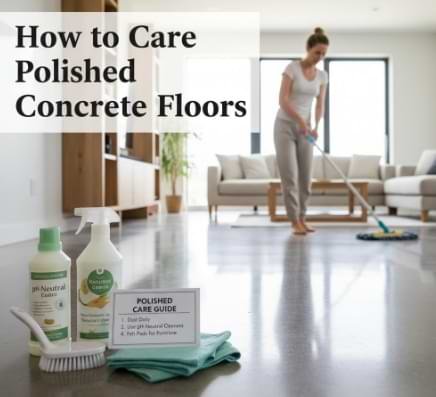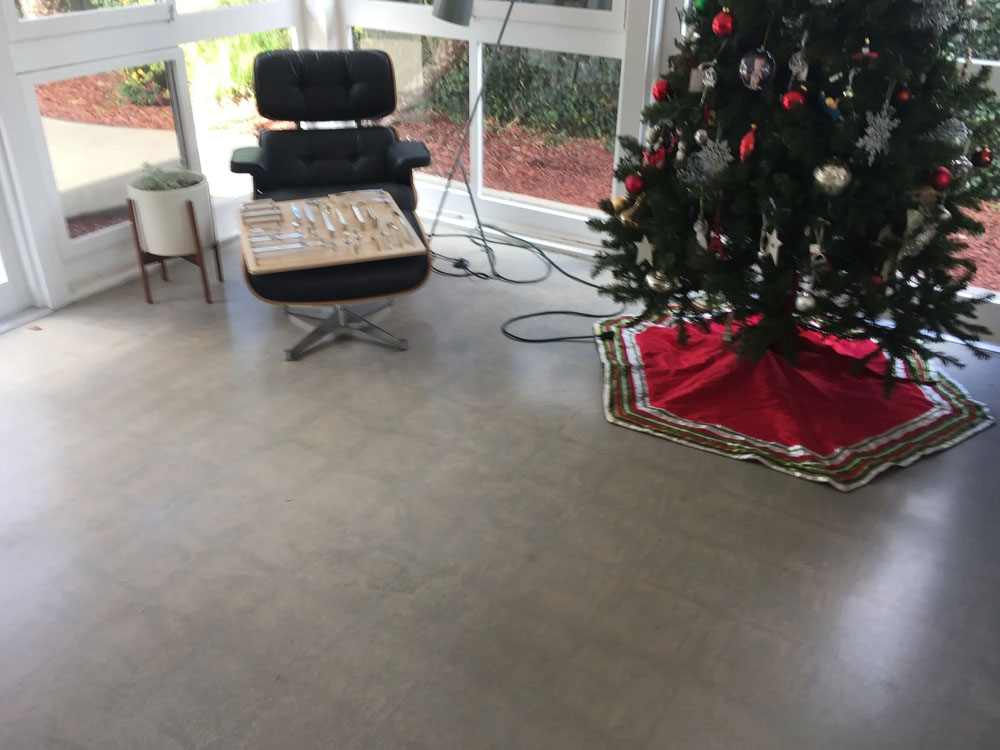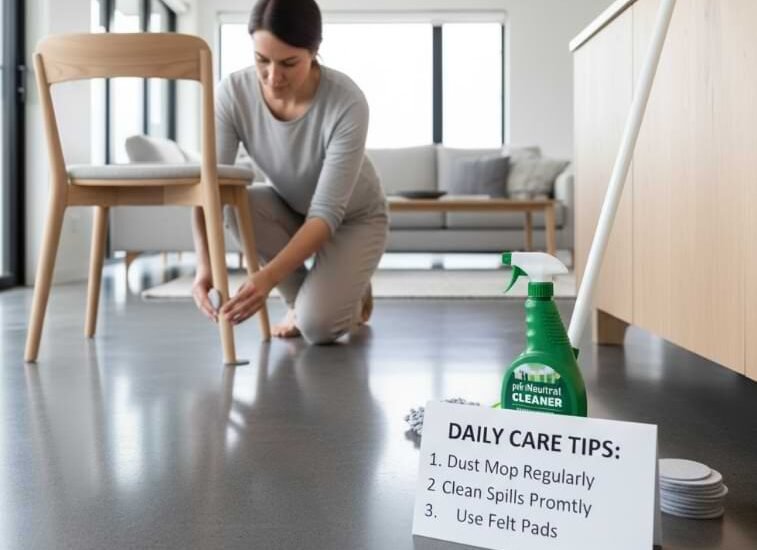Looking for a guide on how to care for polished concrete floors? Polished concrete floors are incredibly durable and low-maintenance, but “low-maintenance” doesn’t mean “no maintenance.” To keep their smooth, glossy finish intact, regular care and smart prevention are key.
The best way to care for polished concrete floors is to clean them consistently, protect against abrasives, and maintain the polish through periodic resealing or buffing.
In this post, you’ll learn exactly how to maintain polished concrete flooring, prevent damage, and extend its lifespan, with practical, experience-based advice from the flooring professionals at Concrete Solutions.
Why Polished Concrete Floors Need Special Care
Polished concrete flooring is created by grinding and sealing concrete to a mirror-like finish. It’s known for:
- Exceptional durability – resists scratches, stains, and heavy foot traffic.
- Aesthetic appeal – adds a sleek, modern look to homes and commercial spaces.
- Low upkeep – less demanding than tile, wood, or carpet.
However, polished surfaces are still vulnerable to dirt, grit, and acidic spills that can dull the shine or etch the surface. Without proper care, the finish may lose its reflective quality over time.
Daily and Weekly Care Routine
1. Dust Mop Daily
Use a microfiber dust mop every day to remove dust, sand, and debris that can scratch the surface. Avoid harsh bristles; they can create micro-abrasions that dull the polish.
2. Clean Spills Immediately
Polished concrete floors are sealed, but not completely stain-proof. Wipe up liquids like juice, oil, or cleaning chemicals right away to prevent discoloration.
3. Damp Mop Weekly
Use a neutral-pH cleaner diluted in warm water (never ammonia or vinegar). Mop the floor using a soft pad or microfiber mop, wringing out excess water.
- Avoid harsh chemicals, which can damage the sealer.
- Rinse the mop often to prevent spreading dirt.
Pro tip: For larger areas, use an auto-scrubber with a non-abrasive pad for an even, streak-free clean.

Deep Cleaning and Polishing Maintenance
Monthly or Quarterly: Light Polish or Buffing
To restore lustre, buff the floor with a high-speed burnisher and diamond-impregnated pads. This removes surface scuffs and restores the gloss without needing a full regrind.
Every 1–2 Years: Professional Re-Sealing
Even the toughest polished concrete flooring benefits from periodic resealing. The professionals at Concrete Solutions recommend resealing high-traffic areas every 18–24 months to preserve the glossy finish and protect against moisture.
Tip: Warehouses, restaurants, and retail spaces may need maintenance more frequently due to heavier use.
How to Prevent Damage to Polished Concrete Floors
A few small habits can make a big difference in keeping your concrete floors beautiful:
Use Entrance Mats
Dirt, sand, and salt brought in from outside can scratch the surface. Place mats at entryways and clean them often.
Avoid Dragging Furniture
Use felt pads under furniture legs. Heavy or sharp-edged objects can cause permanent gouges if dragged.
Protect from Harsh Chemicals
Avoid bleach, ammonia, acidic cleaners, or degreasers; they can etch or cloud the polish.
Control Moisture
If your concrete floors are installed over ground-level slabs, use dehumidifiers to prevent condensation. Excess moisture can affect the sealer’s performance.
When to Schedule Concrete Floor Repair
Even with the best care, minor cracks or surface imperfections can appear over time. Professional concrete floor repair helps restore integrity and prevents damage from spreading.
If you notice:
- Hairline cracks near joints
- Uneven sections or chips
- Areas where the shine has dulled or flaked
It may be time for a touch-up or resurfacing. In some cases, self-leveling concrete can be used to restore an uneven surface before refinishing.
At Concrete Solutions, our team uses precision grinding and repair methods to restore polished concrete flooring without removing the existing slab.
Step-by-Step: How to Clean Polished Concrete Floors
Step 1: Remove loose dirt using a microfiber dust mop.
Step 2: Prepare a neutral-pH cleaning solution in warm water.
Step 3: Mop gently in small sections, avoiding puddles.
Step 4: Allow to air dry or use fans for faster drying.
Step 5: Once dry, inspect for streaks or spots, buff lightly if needed.
Quick takeaway: Clean regularly, use mild cleaners, protect from abrasives, and schedule professional polishing every 1–2 years.
The Role of Professional Maintenance
While DIY care is important, professional maintenance keeps polished concrete floors looking new for decades. Experts use specialized equipment to re-polish, fill cracks, and apply industrial-grade sealers that maintain reflectivity even in high-traffic zones.
Concrete Solutions offers complete care for polished concrete flooring across Orange County, including:
- Re-polishing and resealing
- Self-leveling concrete applications
- Concrete grinding and refinishing
- Joint filling and coating removal
With over 22 years of experience, their technicians ensure a consistent finish that enhances both aesthetics and functionality.
Benefits of Proper Polished Concrete Care
- Extends lifespan: Well-maintained polished concrete can last 20+ years.
- Saves money: Regular cleaning and sealing prevent costly full resurfacing.
- Improves safety: A clean surface offers better traction and less dust.
- Enhances beauty: Maintains the sleek, reflective appearance that defines polished concrete flooring.
FAQs About Polished Concrete Floor Care
Q: Can I use a steam mop on polished concrete floors?
A: No. Steam and heat can damage the sealant and cause clouding or discoloration. Stick to cool, damp mopping.
Q: How do I remove scuff marks?
A: Use a soft cloth or melamine pad (like a Magic Eraser) with a neutral cleaner. Avoid abrasives that can dull the shine.
Q: Are polished concrete floors slippery?
A: Properly finished floors have anti-slip properties. However, water or oil spills can reduce traction; wipe them immediately.
Q: Can I wax polished concrete floors?
A: Wax isn’t necessary and may actually dull the finish. Polished concrete’s natural sheen comes from mechanical polishing, not coatings.
Q: How often should I reseal my concrete floors?
A: Every 18–24 months for most spaces. High-traffic areas like showrooms or warehouses may need more frequent resealing.
Polished concrete floors combine beauty, durability, and sustainability, but they still need consistent care to keep that signature shine. With daily cleaning, smart protection, and occasional professional maintenance, your floors can stay sleek and spotless for years to come.
For expert concrete floor repair, polishing, or maintenance services, contact Concrete Solutions in Orange County today.
How to Care for Polished Concrete Floors (Expert Tips for Lasting Shine)
Polished concrete floors are incredibly durable and low-maintenance, but “low-maintenance” doesn’t mean “no maintenance.” To keep their smooth, glossy finish intact, regular care and smart prevention are key.
The best way to care for polished concrete floors is to clean them consistently, protect against abrasives, and maintain the polish through periodic resealing or buffing.
In this post, you’ll learn exactly how to maintain polished concrete flooring, prevent damage, and extend its lifespan, with practical, experience-based advice from the flooring professionals at Concrete Solutions.
Why Polished Concrete Floors Need Special Care
Polished concrete flooring is created by grinding and sealing concrete to a mirror-like finish. It’s known for:
- Exceptional durability – resists scratches, stains, and heavy foot traffic.
- Aesthetic appeal – adds a sleek, modern look to homes and commercial spaces.
- Low upkeep – less demanding than tile, wood, or carpet.
However, polished surfaces are still vulnerable to dirt, grit, and acidic spills that can dull the shine or etch the surface. Without proper care, the finish may lose its reflective quality over time.
Daily and Weekly Care Routine
1. Dust Mop Daily
Use a microfiber dust mop every day to remove dust, sand, and debris that can scratch the surface. Avoid harsh bristles; they can create micro-abrasions that dull the polish.
2. Clean Spills Immediately
Polished concrete floors are sealed, but not completely stain-proof. Wipe up liquids like juice, oil, or cleaning chemicals right away to prevent discoloration.
3. Damp Mop Weekly
Use a neutral-pH cleaner diluted in warm water (never ammonia or vinegar). Mop the floor using a soft pad or microfiber mop, wringing out excess water.
- Avoid harsh chemicals, which can damage the sealer.
- Rinse the mop often to prevent spreading dirt.
Pro tip: For larger areas, use an auto-scrubber with a non-abrasive pad for an even, streak-free clean.
Deep Cleaning and Polishing Maintenance
Monthly or Quarterly: Light Polish or Buffing
To restore lustre, buff the floor with a high-speed burnisher and diamond-impregnated pads. This removes surface scuffs and restores the gloss without needing a full regrind.
Every 1–2 Years: Professional Re-Sealing
Even the toughest polished concrete flooring benefits from periodic resealing. The professionals at Concrete Solutions recommend resealing high-traffic areas every 18–24 months to preserve the glossy finish and protect against moisture.
Tip: Warehouses, restaurants, and retail spaces may need maintenance more frequently due to heavier use.
How to Prevent Damage to Polished Concrete Floors
A few small habits can make a big difference in keeping your concrete floors beautiful:
Use Entrance Mats
Dirt, sand, and salt brought in from outside can scratch the surface. Place mats at entryways and clean them often.
Avoid Dragging Furniture
Use felt pads under furniture legs. Heavy or sharp-edged objects can cause permanent gouges if dragged.
Protect from Harsh Chemicals
Avoid bleach, ammonia, acidic cleaners, or degreasers; they can etch or cloud the polish.
Control Moisture
If your concrete floors are installed over ground-level slabs, use dehumidifiers to prevent condensation. Excess moisture can affect the sealer’s performance.
When to Schedule Concrete Floor Repair
Even with the best care, minor cracks or surface imperfections can appear over time. Professional concrete floor repair helps restore integrity and prevents damage from spreading.
If you notice:
- Hairline cracks near joints
- Uneven sections or chips
- Areas where the shine has dulled or flaked
It may be time for a touch-up or resurfacing. In some cases, self-leveling concrete can be used to restore an uneven surface before refinishing.
At Concrete Solutions, our team uses precision grinding and repair methods to restore polished concrete flooring without removing the existing slab.
Step-by-Step: How to Clean Polished Concrete Floors
Step 1: Remove loose dirt using a microfiber dust mop.
Step 2: Prepare a neutral-pH cleaning solution in warm water.
Step 3: Mop gently in small sections, avoiding puddles.
Step 4: Allow to air dry or use fans for faster drying.
Step 5: Once dry, inspect for streaks or spots, buff lightly if needed.
Quick takeaway: Clean regularly, use mild cleaners, protect from abrasives, and schedule professional polishing every 1–2 years.

The Role of Professional Maintenance
While DIY care is important, professional maintenance keeps polished concrete floors looking new for decades. Experts use specialized equipment to re-polish, fill cracks, and apply industrial-grade sealers that maintain reflectivity even in high-traffic zones.
Concrete Solutions offers complete care for polished concrete flooring across Orange County, including:
- Re-polishing and resealing
- Self-leveling concrete applications
- Concrete grinding and refinishing
- Joint filling and coating removal
With over 22 years of experience, their technicians ensure a consistent finish that enhances both aesthetics and functionality.
Benefits of Proper Polished Concrete Care
- Extends lifespan: Well-maintained polished concrete can last 20+ years.
- Saves money: Regular cleaning and sealing prevent costly full resurfacing.
- Improves safety: A clean surface offers better traction and less dust.
- Enhances beauty: Maintains the sleek, reflective appearance that defines polished concrete flooring.
FAQs About Polished Concrete Floor Care
Q: Can I use a steam mop on polished concrete floors?
A: No. Steam and heat can damage the sealant and cause clouding or discoloration. Stick to cool, damp mopping.
Q: How do I remove scuff marks?
A: Use a soft cloth or melamine pad (like a Magic Eraser) with a neutral cleaner. Avoid abrasives that can dull the shine.
Q: Are polished concrete floors slippery?
A: Properly finished floors have anti-slip properties. However, water or oil spills can reduce traction; wipe them immediately.
Q: Can I wax polished concrete floors?
A: Wax isn’t necessary and may actually dull the finish. Polished concrete’s natural sheen comes from mechanical polishing, not coatings.
Q: How often should I reseal my concrete floors?
A: Every 18–24 months for most spaces. High-traffic areas like showrooms or warehouses may need more frequent resealing.
Polished concrete floors combine beauty, durability, and sustainability, but they still need consistent care to keep that signature shine. With daily cleaning, smart protection, and occasional professional maintenance, your floors can stay sleek and spotless for years to come.
For expert concrete floor repair, polishing, or maintenance services, contact Concrete Solutions in Orange County today.



